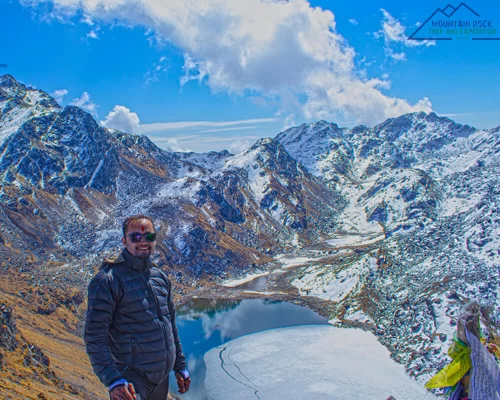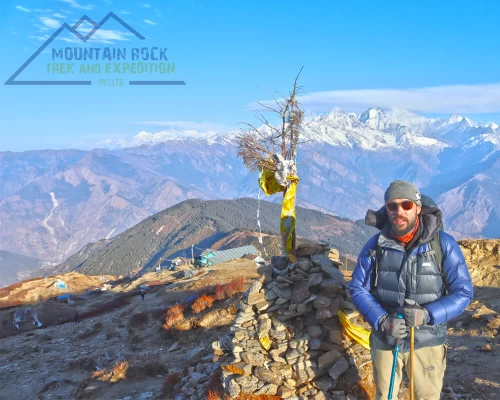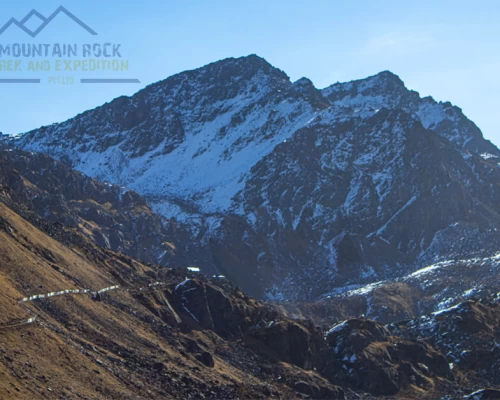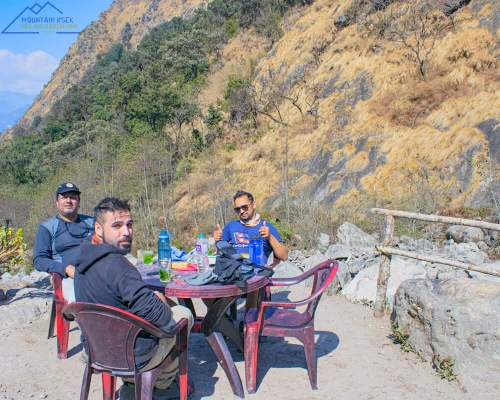Travel insurance necessary for trekking in the Langtang
Yes, Travel insurance is very crucial if you are heading to the Langtang region. Nepal tourism board(NTB) has also given mandatory travel insurance for this permit. Our travel insurance includes both accidental insurance and medical insurance.
Your insurance will facilitate you with helicopter rescue during illness, accidents, and altitude sickness.
During the trek is it uncertain that anything might happen so for your safety it is always best to take travel insurance. Travel insurance ensures you safe traveling. While heading to the Langtang region you will enter many remote villages and unfacilitated areas in the local areas. The Earthquake of 2015 has created massive destruction in some areas of the Langtang region so, better to ensure yourself with the insurance.
What kind of food and accommodation will be served when traveling to the Langtang region?
Mostly the locals of the Langtang region serve Nepali food set that includes Dal Bhat and curry of the organic vegetables grown on their vegetable farm. For breakfast, they serve you tea, juice, pancake, egg, potatoes, and others.
For lunch dinner, You will be served mostly Nepalese cuisine Dalbhat. For trekkers, Dal Bhat is the best food that contains high calories and protein. Nepalese believe nothing can be healthier than Dalbhat. But for lunch, at your request, they will serve you western food items as well. They will provide you with pasta, noodles, spaghetti, some Indian items, and Tibetian items are also available.
For drinks, tea, juice, coke, and hot drinks are also easily accessible in this region. While walking in the high mountains, water is the most important and necessary resource. On the journey, there are lots of freshwater resources and tap water. All you need is a water purifier and a purifier tab with you so you may filter whenever you want. Bottled water is also available along the journey at tea houses and small shops. At hotels, you may always replenish a bottle of water for free or for a little fee.
Accommodation facility in the Langtang region
The trekking trail to the Langtang region has many lodges and hotels. You will also encounter many tea houses. You usually trek from one village to the next, and there are usually enough lodges for a normal stay. Some of the hotels, provide clean and comfortable guestrooms with adjoining bathrooms. Although some standard hotels have common bathrooms, you may simply book a separate room.
As you climb higher in altitude, you'll notice that the accommodations become more basic. There are usually twin basis rooms as well. In the room, there will be two single beds with mattresses, blankets, and pillows. After a long day of walking, trust me when I say that these accommodations will seem like a luxury.
In the lowest reaches of the Langtang valley, single rooms are available. However, at higher altitudes, the odds of finding a solitary room are slim, since the number of teahouses decreases as you go. You may not be able to find one even if you are ready to spend extra.
Do we need trekking permits in the Langtang region?
Yes, we need a permit for Langtang trekking. The Entry permit fee for foreigners is NPR 3390 including 13% of VAT.
Langtang National Park contains trekking trails in the Langtang area. Foreign visitors must pay an entrance charge and receive a TIMS card to hike in the Langtang area.
Some tips about electricity and internet facility in the Langtang region
Although electricity is accessible during the walk, there may be a few power outages. Low-voltage lights are used in tea establishments. Despite the presence of power, some tea shops charge between USD 2 and USD 5 to charge your phones and batteries. As a result, if feasible, bring a power bank or a solar charger with you.
Having access to the internet on these trips to remote locations is considered a privilege. From Kathmandu to Syabrubesi, it is freely available; however, as you travel higher, availability gets more difficult and costs money. You will have to pay an additional fee. You can expect sporadic or non-existent Wi-Fi. Instead, buy a local GSM-operated SIM card in Kathmandu and utilize the GRPS by purchasing a mobile data pack, which may be less expensive.
What to do if I get caught with altitude sickness during the trek?
When your body is exposed to a greater elevation for a lengthy period, you will experience altitude sickness.
When people are traveling and rising or being moved to a higher level fast, altitude sickness is prevalent. The lower the air pressure and oxygen levels are, the higher you climb. Our bodies are capable of handling the change, but it will take time for them to acclimate. Preventing altitude sickness also requires staying hydrated. During your climb, drink plenty of water. Climb at a comfortable speed for you. It's also crucial to remember that even if you're taking acetazolamide, you might still experience altitude sickness. The drug will not help you if you already have symptoms. The only effective cure is to descend to a lower altitude.
When traveling to higher altitudes there is a very maximum chance of suffering from AMS (Acute mountain sickness).
So to prevent AMS, we will take two acclimatization breaks every thousand meters. We will trek at the higher altitude but sleep in the lower to cure this altitude sickness. If suffered from acute mountain sickness we will take rest immediately at the same place. We will drink more liquid to stay hydrated like soup and water to energize. If the case starts to get worsen we will have to take rescue by helicopter.
What should I pack for my journey?
The items and equipment that we will need to bring with us on the trek are listed below.
FOR THE UPPER HALF OF THE BODY
HAT: To keep the sun off your face, you'll need a decent, wide-brimmed trekking hat. The greatest styles are those that are lightweight, easy to carry, and cover the neck. The most important reason to wear a hat when hiking is to shield yourself from the sun.
HEADLAMP: Along with the hat, it's a good idea to bring a headlamp on the hike. A headlamp is a light that is worn on one's head. These gadgets are ideal for traveling and hiking since they operate without using your hands. When hiking, it's best to have your hands free so you can cope with anything Mother Nature strikes at you or retrieve your stuff. Trails may be difficult to navigate at night. Pebbles, tree roots, twigs, and even animals are commonly seen in these footsteps, which resemble an undiscovered maze. Any of these dangers can be deadly, and keeping your hand's free lets you catch yourself, move obstacles, race, or defend yourself against an irate rabbit on the track.
WOOLEN HAT: When you move to higher elevations you get a high chance of being caught by cold. So, it is suggested to carry a woolen hat with you for your protection. Not every hat is equally suitable for trekking so, it is safer to carry a woolen hat, in case you need it, it will be available with you.
SUN PROTECTING HAT: Day during your trial can be sunny and the rays directly showered upon you. It will protect UV rays from entering your skin. We must be more careful regarding our heads and protect the scalp from sunburn and skin cancer.
SUNGLASSES: As we move towards high altitude, the atmospheric layer becomes thinner which increases exposure to harmful rays because the capacity to filter these rays becomes less. Therefore, to protect your eyes from harmful rays we need to carry sunglasses.
RAINPROOF JACKETS AND TROUSERS: Hiking in the rain is always a possibility, especially between June and September (we strongly advise against walking in the region during these months). We recommend taking rain gear, ideally a gore-tex membrane hardshell jacket, as a precaution. When it comes to pants, a cheap pair of waterproof pullovers is usually sufficient.
T-SHIRT: It is recommended that you wear light clothing when trekking to minimize excessive perspiration and discomfort. During such journeys, a t-shirt is the finest option. Due to the significant variation in height and hence temperature, layering is an important part of the hike. If you can add and remove layers of clothing while hiking, you'll be able to readily adjust to the weather and be comfortable and safe. If you want to go trekking in the chilly winter months of December through February, carry some additional clothing.
DOWN JACKET: A down jacket is one of the most important purchases you'll make. Having the appropriate warm, insulating layer on a hiking or climbing trip may make or break your enjoyment level. Especially when planning a hike in the Everest region, a down jacket should be included on your packing list.
GLOVES: You should bring your gloves with you because they will protect your hands from sweat, extreme weather, and other inconvenient situations that could result in discomfort or injury.
CLOTHING FOR THE LOWER BODY
- THERMAL INNERS: Thermal inners serve as a barrier between your body and the chilly air outside. They reduce heat loss by trapping body heat. Use ones that are often composed of polyester or any other material that provides additional comfort and flexibility.
- TROUSERS: A full-length pair of trekking trousers protect you from thorny plants, twigs, rocks, and other hazards by providing sturdy route protection. This has the benefit of allowing you to stroll quietly without being disturbed by rustling foliage, as well as getting close to animals without bothering them.
FOOTWEARS
- TREKKING BOOTS: Trekking boots are required since they are particularly developed to protect the foot and ankles during long-distance trekking. They are one of the most crucial aspects of trekking since they might influence a trekker's ability to travel long distances without being injured.
- SOCKS: Blisters can be avoided by wearing hiking socks. A hiking sock, unlike a flimsy, stinky cotton sock, will not constantly rub against the back of your foot and will provide significant protection from friction generated by your shoe. The socks keep the feet at a steady temperature. On the foot, socks are extremely soft and comfy.
OTHER TYPES OF TREKKING EQUIPMENT
- TREKKING POLES: Trekking poles include your arms and shoulders into your stride, allowing you to employ stronger muscles to push yourself uphill and regulate your descent. As a result, the rate increases without the accumulation of leg pain.
- FIRST-AID KIT: Every trekker should have a first-aid kit. During the trial, they assist you with any necessary therapy. As a result, we must carry it with us to reduce the danger of infection or damage severity. Burns, bruises, scratches, and cuts may all be treated with a well-stocked pack.
- SLEEPING BAGS: Even though we will be staying in hotels with services, you should still take precautions and bring a sleeping bag with you. It is advised that you bring your sleeping bags with you on the path if you want to get the finest night's sleep possible.
- PERSONAL BAGS: One thing you want to be assured of while embarking on an outdoor excursion is that you'll be comfy the entire time. This is especially true if you plan on hiking a long and arduous trail. The sort of hiking backpack you choose will have a big influence on how much fun you have on your expedition. If you're hauling a lot of stuff, you'll want a bag that evenly distributes the weight so you don't become fatigued too quickly.
Importance of passport and visa during the trek
When we go on a journey, the most important thing we need is a passport. At least one copy of our passport and visa is required. We will receive the visa before we arrive. To visit the Langtang area, you'll need a Nepal visa. You may get a visa on arrival at the main points of entry, but if you like to be prepared, you can apply for a Nepal visa ahead of time. You must carry your passport and two passport-size photographs with you at all times.
How are the guides, Potters, and Tipping systems in Nepal?
Our Langtang hiking guides and porters will be fully insured and informed about the entire Langtang region, not just Langtang trekking. Since the commencement of the Langtang region Trek, we have been assisting and promoting local people. We guarantee that we will provide you with excellent guides and skilled porters for your trekking trips in Nepal.
Local Guides are English-speaking individuals who will assist you on the trail for the duration. They will not be able to carry your luggage, but they will be able to answer your questions and give information about the area as you go. It is always recommended that you go with a guide. When traveling at a high height, you may have AMS; nevertheless, if you are unfamiliar with hikes, your guide will be extremely helpful.
Porters will just carry your stuff for you during the travel. They don't speak much English and won't be able to understand any questions you ask. You may move freely by bringing your porter with you, who will assist you in carrying your belongings.
Tipping will cost you ten percent of the entire bill. This ten percent is split between the guide and the porter, with 60 percent going to the guide and 40 percent going to the porter.
TERMS AND CONDITIONS OF BOOKING
We are flexible with bookings, however, you must pay a 30% deposit when you confirm your reservation, with the balance required upon arrival. There are no hidden costs with us.
If you wish to join a group, you may learn more about the terms and conditions by contacting us.
All of our reservations are handled by Mountain Rock Treks & Expedition Pvt. Ltd. To reserve a package, fill out a Booking Form and return it to the business together with your deposits and insurance payment (if applicable). You will be required to pay a non-refundable deposit of 25% of the trip price at the time of booking for all trips. Once you arrive in Kathmandu and before the trip begins, you can pay the remaining balance.
The Company or its Agent should receive the non-refundable deposit. When scheduling a personalized vacation with the company, a larger deposit or full payment may be expected upfront. If a deposit is required in addition to that stated in this section, the firm will inform you at the time of booking. A bank transfer or a credit card deposit can be used to reserve a reservation (Visa or MasterCard).
Is a last-minute booking possible?
We are flexible with bookings, but last-minute cancellations are not refundable. You must pay the complete package fee to secure your spot on one of our Langtang area trekking trips at the last minute. We'll do our best to complete the task before the deadline. For the best experience, arrive in Kathmandu at least a day ahead of time. For further information, please contact us directly.
A Client's order cancellation must be submitted in writing and validated by the Company. The cancellation price is determined by the date the Company or its Agents receives the cancellation request. If you cancel your reservation at the last minute after it has been confirmed, you will forfeit the 25% deposit. You will be liable for the entire cost of the trip if you decide to cancel your trip after it has begun for any reason. We can't give you a refund once you've begun your adventure. It is strongly recommended that the Client purchase cancellation insurance at the time of booking.
TREKKING THAT CAN BE DONE IN LANGTANG REGION
- TAMANG HERITAGE (MODERATE)
- LANGTANG VALLEY TREKKING (MODERATE)
- HELAMBU CRCUIT TREKKING (MODERATE)
- GOSAIKUNDA LAKE TREKKING (MODERATE)
- GONJA LA PASS TREKKING (MODERATE)
- LANGTANG GOSAIKUNDA LAUREBINA PASS TREKKING (MODERATE)
.webp)

.webp)
.webp)

.webp)




.jpg)




